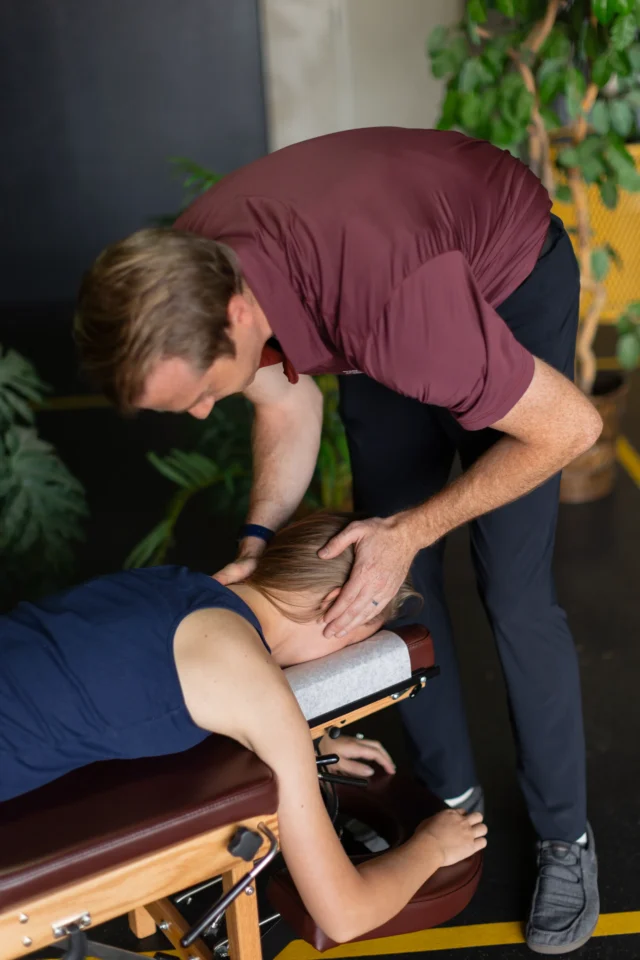Poor posture affects 75% of office workers, leading to chronic pain, decreased productivity, and long-term health issues. But here’s the good news: with the right ergonomic setup and core strengthening approach, you can transform your posture whether you’re sitting or standing. This comprehensive guide reveals how to optimize your workspace and build the foundation for lifelong spinal health.
Understanding Posture and Ergonomics: The Foundation of Pain-Free Living
Posture refers to how you hold your body while sitting, standing, or moving. Good posture maintains the natural curves of your spine while distributing weight evenly across your joints and muscles. Ergonomics, on the other hand, is the science of designing your environment to fit your body’s needs and capabilities.
When your posture is aligned correctly, your muscles work efficiently with minimal strain. Your head sits directly over your shoulders, your shoulders rest over your hips, and your spine maintains its natural S-shaped curve. This alignment reduces pressure on your joints, prevents muscle fatigue, and allows your body to function optimally.
Poor posture creates a domino effect of problems. Forward head posture strains your neck muscles and compresses nerves. Rounded shoulders tighten your chest muscles while weakening your upper back. A tilted pelvis places excessive stress on your lower back and can lead to hip dysfunction.
The key to maintaining good posture lies in understanding that it’s not about forcing your body into a rigid position. Instead, it’s about creating an environment that supports your natural alignment while building the strength and flexibility needed to maintain it throughout the day.
The Core-Posture Connection: Why Your Abdominal Muscles Matter Most
Your core muscles serve as your body’s natural corset, providing stability and support for your spine in every position. These muscles work together to maintain proper posture whether you’re sitting at a desk or standing at a counter.
The core consists of several muscle groups that function as a team. The transverse abdominis wraps around your torso like a deep internal belt, providing stability for your spine. The diaphragm forms the top of your core cylinder, while the pelvic floor muscles create the bottom. The multifidus muscles provide fine-tuned control for individual vertebrae, and the obliques help with rotation and side bending.
When your core muscles are strong and functioning properly, they create intra-abdominal pressure that supports your spine from the inside. This internal pressure acts like a balloon, reducing the load on your vertebrae and discs. Without adequate core strength, your spine lacks the stability needed for proper posture, forcing other muscles to compensate and leading to pain and dysfunction.
Research shows that people with chronic back pain often have delayed activation of their core muscles. This delay means their spine lacks support during movement, increasing the risk of injury and perpetuating pain cycles. Strengthening your core doesn’t just improve your posture—it’s essential for ending back pain for good.
Core strength also improves your body’s ability to maintain proper alignment throughout the day. When your core is strong, you naturally sit and stand taller without conscious effort. Your breathing improves, your energy levels increase, and you experience less fatigue from maintaining good posture.
Mastering Sitting Ergonomics: Your Complete Desk Setup Guide
Creating an ergonomic sitting environment starts with your chair. Your chair should support the natural curve of your lower back, allowing your feet to rest flat on the floor with your knees at approximately 90 degrees. If your chair lacks proper lumbar support, use a small pillow or rolled towel to maintain the curve in your lower back.
Your monitor placement significantly impacts your neck and shoulder posture. Position your screen so the top of the monitor is at or slightly below eye level, about arm’s length away. This positioning prevents you from tilting your head up or down, reducing strain on your cervical spine. If you use multiple monitors, position them at equal heights and angles to avoid repetitive neck rotation.
Keyboard and mouse positioning affects your shoulder and wrist alignment. Your keyboard should sit at a height that allows your shoulders to relax with your elbows at approximately 90 degrees. Your wrists should remain in a neutral position, not bent up or down. Position your mouse at the same level as your keyboard and close enough that you don’t have to reach for it.
Your desk height should allow your arms to rest comfortably at your sides with your forearms parallel to the floor. If your desk is too high, consider using a keyboard tray. If it’s too low, raise it or use a cushion to elevate your sitting position.
Lighting plays a crucial role in maintaining good posture. Poor lighting causes you to lean forward or tilt your head to see better, disrupting your alignment. Position your monitor perpendicular to windows to reduce glare, and ensure adequate task lighting for reading documents.
Standing Desk Ergonomics: Optimizing Your Vertical Workspace
Standing desks have gained popularity as a solution to prolonged sitting, but proper setup is crucial for maintaining good posture and preventing fatigue. Your standing desk height should allow your arms to rest comfortably at your sides with your forearms parallel to the floor when typing.
Monitor placement remains critical when standing. The top of your screen should be at or slightly below eye level, requiring you to look straight ahead or slightly down. This positioning prevents neck strain and maintains the natural curve of your cervical spine. You may need to adjust your monitor height when transitioning between sitting and standing.
Weight distribution and foot positioning significantly impact your standing posture. Stand with your feet hip-width apart, distributing your weight evenly between both feet. Avoid locking your knees or shifting your weight to one leg, as this can cause muscle fatigue and misalignment. Consider using a footrest or rail to occasionally rest one foot, alternating between legs.
An anti-fatigue mat provides cushioning and encourages subtle movement while standing. These mats reduce pressure on your joints and help prevent the stiffness that comes from standing on hard surfaces for extended periods.
The transition between sitting and standing should be gradual. Start with 15-20 minute intervals of standing, gradually increasing as your body adapts. Listen to your body and sit when you feel fatigued. The goal is to alternate between positions throughout the day, not to stand continuously.
Strengthening Exercises for Better Posture
Building core strength is essential for maintaining good posture in any position. Start with basic exercises that teach you to engage your deep core muscles properly.
Diaphragmatic breathing forms the foundation of core activation. Lie on your back with your knees bent and one hand on your chest, one on your belly. Breathe slowly, expanding your belly while keeping your chest relatively still. This exercise activates your diaphragm and teaches you to engage your core muscles naturally.
The dead bug exercise teaches core stability while moving your limbs. Lie on your back with your arms extended toward the ceiling and your knees bent at 90 degrees. Slowly lower your opposite arm and leg toward the floor while maintaining a stable core. This exercise challenges your ability to maintain spinal alignment while moving.
Wall sits strengthen your legs and teach proper standing posture. Stand with your back against a wall, feet hip-width apart and about 18 inches from the wall. Slide down until your thighs are parallel to the floor, keeping your back pressed against the wall. This exercise builds endurance in the muscles needed for good standing posture.
Planks build overall core strength and endurance. Start with a modified plank on your hands and knees, then progress to a full plank maintaining a straight line from head to heels. Focus on breathing normally while holding the position, gradually increasing the duration as you get stronger.
Cat-cow stretches improve spinal mobility and teach you to control your spinal position. Start on your hands and knees, then alternate between arching your back (cow) and rounding it (cat). This exercise helps counteract the effects of prolonged sitting or standing in one position.
Daily Habits for Optimal Posture
Maintaining good posture requires consistent daily habits that support your spinal health. Regular movement breaks are essential, regardless of whether you’re sitting or standing. Set a timer to remind yourself to change positions every 30-45 minutes. Use these breaks to walk, stretch, or perform simple exercises.
Proper lifting technique protects your spine during daily activities. Bend at your knees and hips, not your waist. Keep the object close to your body and engage your core muscles before lifting. This technique applies to everything from picking up a pen to lifting heavy boxes.
Sleep posture significantly impacts your daytime alignment. Use a supportive pillow that maintains the natural curve of your neck. If you sleep on your side, place a pillow between your knees to maintain hip alignment. Back sleepers should place a pillow under their knees to reduce pressure on the lower back.
Stress management plays a crucial role in posture. Chronic stress causes muscle tension, particularly in the neck and shoulders. Practice relaxation techniques such as deep breathing, meditation, or gentle yoga to reduce stress-related muscle tension.
Stay hydrated and maintain proper nutrition to support muscle function and joint health. Dehydration can cause muscle fatigue and cramping, making it harder to maintain good posture throughout the day.
When to Seek Professional Help
While proper ergonomics and core strengthening can significantly improve your posture, some situations require professional intervention. Chronic pain that persists despite your efforts may indicate underlying issues that need specialized treatment.
Muscle imbalances and movement dysfunctions can prevent your core muscles from functioning properly. These issues often develop over time and may require specific techniques to address. Advanced treatment methods like AMIT (Advanced Muscle Integration Technique) can identify and correct these imbalances.
Neurological factors may also interfere with proper muscle activation. NPI (Neural Pathway Integration) addresses communication issues between your brain and muscles, ensuring your core can function optimally to support your spine.
If you experience numbness, tingling, or radiating pain, seek professional evaluation promptly. These symptoms may indicate nerve compression or other serious conditions that require immediate attention.
Transform Your Posture, Transform Your Life
Good posture isn’t just about looking confident—it’s about feeling your best and preventing pain that can limit your activities and quality of life. The combination of proper ergonomics, core strengthening, and healthy daily habits creates a powerful foundation for lifelong spinal health.
Start implementing these strategies today, beginning with your workspace setup and basic core exercises. Remember that improving posture is a gradual process that requires patience and consistency. Focus on small, sustainable changes that you can maintain long-term.
If you’re dealing with chronic pain or haven’t found relief through exercise and ergonomic improvements alone, consider seeking professional help. Dr. Gavin Hall at Straight Up Chiropractic in St. George, Utah, specializes in advanced techniques like AMIT and NPI that address the root causes of postural problems and back pain.
Your journey to better posture starts with a single step. Take that step today, and experience the transformation that comes with proper alignment, reduced pain, and improved function. Your spine—and your entire body—will thank you for making this investment in your health. Contact Straight Up Chiropractic today for more health tips!



